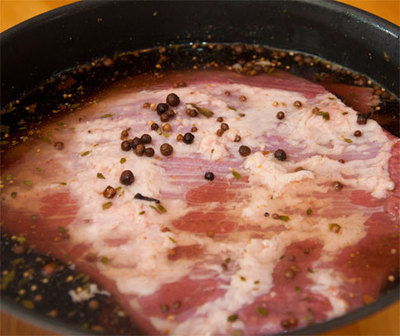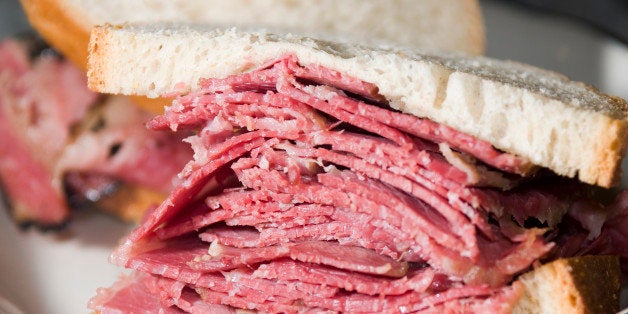
Your first question has to be "Why bother?" And the answer is simple. Homemade corned beef is better.
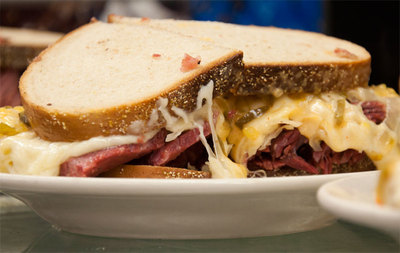
Why? The commercial stuff, especially the cheap stuff mass marketed for St. Patrick's day for Irish wannabes, is usually made by taking shortcuts that result in odd flavors and gelatinous textures. Home made corned beef can also be cheaper. And it's easy. And you can customize it. Once you've had the real deal, you can't go back. It just takes time. So start now.
Corned beef has no corn. OK, maybe the steer ate some corn, but no corn is harmed in the process of corning beef. Actually, to be precise, corn was the old British name for grain before corn on the cob was discovered in North America and usurped the name. "A corn of salt" was as common an expression as a "grain of salt" is today. So corned beef is really just another name for salted beef.
So corning has become another name for curing or pickling. Yes, we are pickling this beef. These are ancient processes invented for preserving meat by packing it in salt or soaking it in a concentrated brine, long before refrigerators. In recent years, curing is also done by injecting meat with salt. The process was probably discovered when some ancient hunter speared a deer and it fell into the ocean and washed ashore a couple of weeks later. Surprisingly instead of bloating and turning foul, the meat had been preserved, and tasted pretty good.
The salt concentration for curing is much higher than the typical 4 to 6% brine used to moisten chicken, turkey, and pork before cooking.
Corned beef was a World War II staple among civilians in Great Britain and among the troops in Europe because fresh meats were hard to come by. It came in a can. Sliced corned beef is especially popular in Jewish delicatessens where it is a sandwich staple.
A vital part of the process is your selection of the meat. Corned beef is simply a slab of beef, usually a section of the brisket or navel, soaked for about a week in a flavored brine. The navel is usually cheapier, and has more fat so it is more tender. But it is hard to find and you may have to special order it.
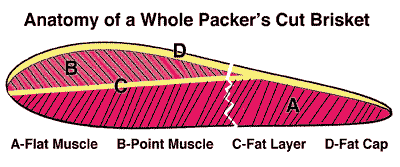
A whole "packer" brisket is a large hunk of meat made of two muscles and can weight up to 18 pounds. It can be bought whole, but is usually cut near the middle and sold as flat or point sides.
Brisket is a pair of thick muscles from the steer's chest, plate is just behind it, and navel just behind the plate.
These cuts are heavily worked muscles and are tough cuts left for the poor folks by the big shots on Wall Street. Making it into pastrami is a great way to tenderize and flavorize these otherwise lesser cuts, and a great way to preserve meat in the days before refrigeration.
This is a two step process. One step is to cure or corn the beef, and the next step is to cook it. You can make traditional corned beef and cabbage boiled dinner, you can make corned beef hash, you can make Reuben sandwiches. If you want, you can add two extra steps, smoke it and steam it to turn it into incredible pastrami.
Makes. 12 big fat NY Deli sandwiches
Preparation time. 1 hour
Curing time. 5-7 days
Ingredients
About 8 pounds of beef brisket or navel
1 gallon water
1 cup brown sugar, preferably dark
8 ounces salt, by weight
4 teaspoons pink curing salt #1
5 tablespoons pickling spices
4 cloves garlic, smashed or pressed
About the pink curing salt #1. This stuff is sodium nitrite, and you can often find it at groceries, butcher shops, or online (click the link above to find it on Amazon). It is also called Prague Powder #1. It kills bacteria, especially the botulism bug, and it is needed for the bright pink color we associate with corned beef. You can skip it and just add 4 teaspoons more table salt, but the meat will be tan in color. It is different from pink curing salt #2 which has both sodium nitirite and sodium nitrate. It is also different from saltpeter which used to be used but isn't used much any more, and it is not the same as Morton Tender Quick, which some people use. Click here for more info on nitrites and nitrates.
About the salt. When you weigh salt, it doesn't matter what type of salt you use. When you measure by volume, there is a big difference because different salts have different grain sizes. I prefer kosher salt because it has fewer additives. For more about different salts, read my article on the Zen of Salt.
About the beef. Some delis use the fattier navel cut. You can also use boneless short rib meat, flank steak, tongue, or round, but round can be very thick, so cut in into 1.5" planks. For that matter you can use any cut you want, but brisket is my fave.
About the pickling spices. You can buy them premixed or click here for a recipe for pickling spices that you can make yourself.
Do this
1) Find a container large enough to handle 1 gallon of brine and the meat (you can cut it into pieces as small as 2 pounds). It must be non-reactive (stainless steel, glass, porcelain, Corningware, or food safe plastic). It cannot be made of aluminum, copper, or cast iron, all of which can react with the salt. Do not use garbage bags or a garbage can or a bucket from Home Depot. They are not food grade. Do not use a styrofoam cooler. It might give the meat an off flavor and you'll never get the cooler clean when you're done. Zipper bags work fine. You can use Reynolds Brining Bags, Ziploc XL, and XXL bags.
2) Mix the brine in 1 quart very hot water. Add 3 quarts very cold water.
3) Take the meat and remove as much fat as possible from the exterior unless you plan to use some of it for pastrami. Then leave a 1/8" layer on one side. Because corned beef is cooked in simmering water, the fat just gets gummy and unappetizing. But if you plan to then make pastrami from it, you will be smoking the meat and in that case the fat gets succulent and lubricates the sandwich. I like to buy a full packer brisket and separate the point from the flat, and cut the flat in half when making corned beef or pastrami. That gives me 3 manageable hunks of 2 to 4 pounds each. If you leave the point attached to the flat beneath, it will be very thick and take longer to cure.
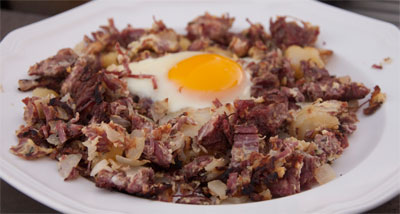 4) Add the meat to the brine. It will float, so put a plate or bowl or another non-metallic weight on top of the meat until it submerges. The meat will drink up brine so make sure there is enough to cover it by at least 1" or else you'll find the meat high and dry after a few days. Refrigerate. Let it swim for at least 5 days, longer if you wish, especially if the meat is more than 2" thick. You will not likely need more than 7 days, but once it is well cured, it can stay in the brine for several weeks. I don't know the limit, but I've left it in there for a month. Move the meat around so touching parts get exposed to brine for the first week, and then you can ignore it.
4) Add the meat to the brine. It will float, so put a plate or bowl or another non-metallic weight on top of the meat until it submerges. The meat will drink up brine so make sure there is enough to cover it by at least 1" or else you'll find the meat high and dry after a few days. Refrigerate. Let it swim for at least 5 days, longer if you wish, especially if the meat is more than 2" thick. You will not likely need more than 7 days, but once it is well cured, it can stay in the brine for several weeks. I don't know the limit, but I've left it in there for a month. Move the meat around so touching parts get exposed to brine for the first week, and then you can ignore it.
5) Now decide which path you want to follow. You can make traditional corned beef and cabbage boiled dinner, you can make corned beef hash, you can make Reuben sandwiches, or turn it into incredible pastrami.
Tell us if you eat corned beef for St. Patrick's Day in the comments below.
All text and photos are Copyright (c) 2012 By Meathead, and all rights are reserved. For more of Meathead's writing, photos, recipes, and barbecue info please visit his website AmazingRibs.com and subscribe to his email newsletter, Smoke Signals.
Friend Meathead on Facebook: http://www.facebook.com/AmazingRibs

